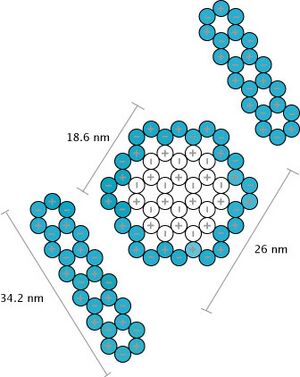IGEM:Harvard/2006/Container Design 2
From OpenWetWare
Jump to navigationJump to search
Container 2.0
ascii
oligo path
Design structure

- Barrel: 30 helices @ 84bp each, each side 18.6nm long, widest point 29nm long
- Lids: double-ply, 26 helices @ 84bp each, 34.2nm long
Notes about designs
- Calculating coil length: The distance between stacked base pairs is approximately (3.4 nm / turn) / (10.5 bp / turn) = 0.324 nm / bp.
- Calculating sheet length: The length of a "sheet" can be calculated using simple trigonometry, as demonstrated by the diagram below.
- The effective diameter of a coil is 3 nm according to Dr. Shih, but I'm not 100% sure that this figure is correct, so I will call it d until we can verify it.
Design details
based on n = 0.324 nm, d = 3.0 nm
| Shape | Lid ply | Cylinder design | Lid design | Total scaffold length |
| honeycomb hexagon | double | 30 tubes (29.0 nm dia) x (84+12)bp long (30.8 nm) | 26 tubes (34.2 nm) x (84+12)bp long (30.8 nm) | 7872 |
ASCII Files
- Media:container2barrel.txt
- (The example hexagonal barrel that William had put up onscreen during the presentation, which is also the one we planned for this design.
- Media:container2lid.txt
- Double-ply lid, will need to be fed two different M13 sequence portions, bookending the main barrel's sequence, to be added.
Oligo Sequences (84bp-long helices)
NB: These oligos still seem to be wrong, despite the feeding of p7308 sequence chunks appropriately separated by 12bp linkers.
- Lid 1: Media: design2oligo_sequenceslid1.txt
- Oligos for the first lid (program was fed the lid ASCII, 2*42bp per helix, and the first 84bp*26helices of the p7308 sequence)
- Barrel: Media: design2oligo_sequencesbarrel.txt
- Oligos for the barrel (program was fed the barrel ASCII, 2*42bp per helix, and the second chunk of the p7308 sequence - ie. 84bp*30helices)
- Lid 2: Media: design2oligo_sequenceslid2.txt
- Oligos for the second lid (program was fed the lid ASCII, 2*42bp per helix, and the third chunk of the p7308 sequence - ie. 84bp*26helices)
- p7308 Sequence Chunk, Lid 1: Media: first84bpx26h.txt
- Sequence fed for the first lid.
- p7308 Sequence Chunk, Barrel: Media: second84bpx30h.txt
- Sequence fed for the barrel.
- p7308 Sequence Chunk, Lid 2: Media: third84bpx26h.txt
- Sequence fed for the second lid.